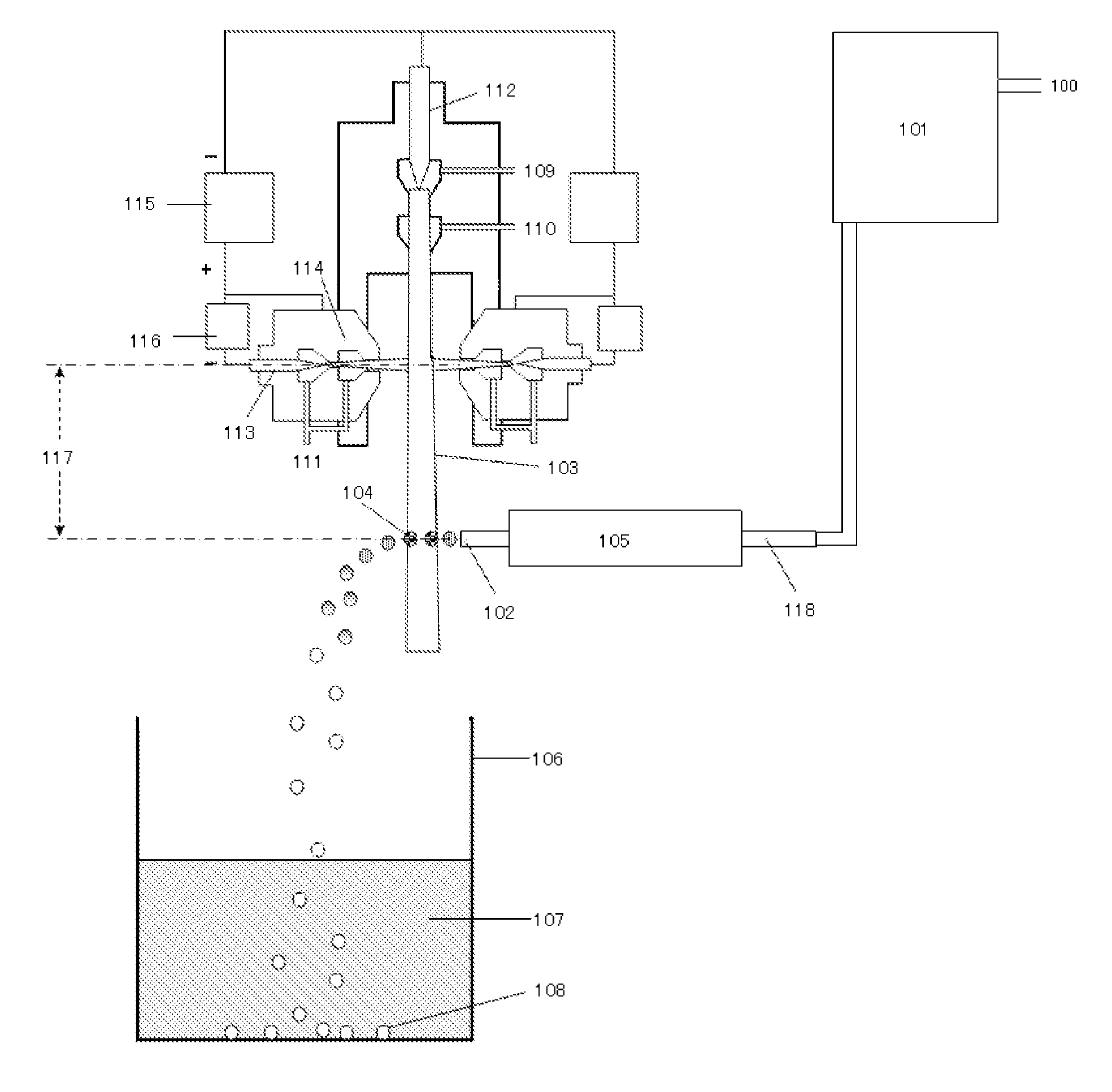Ceramic beads with smooth surfaces and process for producing the same
a technology of ceramic beads and smooth surfaces, applied in the field of ceramic beads, can solve the problems of difficult to sufficiently round the particles, low wear resistance, etc., and achieve the effect of satisfactory shape, less apt to burst, and efficient production
- Summary
- Abstract
- Description
- Claims
- Application Information
AI Technical Summary
Benefits of technology
Problems solved by technology
Method used
Image
Examples
example 1
[0116]Ceramic beads were produced using the apparatus configuration shown in FIG. 1.
[0117]An yttria-containing (3% by mole) partially stabilized zirconia powder which had an average particle diameter of 50 μm and which had been obtained through granulation by an in-liquid granulation method and through sintering was introduced as a raw material into the powder feeder 101. A laminar-flow thermal plasma was generated while feeding argon gas 109, argon gas 111, and a plasma gas 110 composed of nitrogen and 20% hydrogen added thereto, at rates of 3.0 SLM, 2 SLM, and 6 SLM, respectively, and supplying an electric power at 24 kW (160 V×150 A).
[0118]Subsequently, the raw-material powder was supplied with a carrier gas 100, which was nitrogen introduced at 6 SLM, by means of the powder feed 101 at a rate of 20 g / min into a quartz pipe 118 having an inner diameter of 2 mm disposed in a tubular electric furnace 105 having a length of 1 m and having a temperature regulated to 1,000° C. The hea...
example 2
[0124]The powder was supplied for 10 minutes under the same conditions as in Example 1, except that the nitrogen carrier gas 100 was introduced at 4 SLM. The flow rate of the carrier gas being ejected in this operation was estimated at 90 m / sec using equation (1), and the discharge angle was 71°. The partially stabilized zirconia beads obtained were taken out by filtration and dried.
[0125]The surfaces and sections of the partially stabilized zirconia beads obtained were examined with an SEM. As a result, it was found that most of the fine grains on the bead surfaces had disappeared as a result of melting and the surfaces had been smoothed. A more even spherical shape was thus obtained, and the proportion of smooth beads was 95% or higher. Neither surface crack defects nor bead breakage both attributable to a thermal shock was observed. The internal void ratio was 5%. Furthermore, the beads were evaluated for wear characteristics and, as a result, the amount of zirconia was found to ...
example 3
[0127]The powder was supplied for 10 minutes under the same conditions as in Example 1, except that the nitrogen carrier gas 100 was introduced at 10 SLM. The flow rate of the carrier gas being ejected in this operation was estimated at 230 m / sec using equation (1). The partially stabilized zirconia beads obtained were taken out by filtration and dried.
[0128]The surfaces and sections of the partially stabilized zirconia beads obtained were examined with an SEM. As a result, it was found that most of the fine grains on the bead surfaces had disappeared as a result of melting and the surfaces had been smoothed. A more even spherical shape was thus obtained, and the proportion of smooth beads was 95% or higher. Neither surface crack defects nor bead breakage both attributable to a thermal shock was observed. The internal void ratio was 3%. Furthermore, the beads were evaluated for wear characteristics and, as a result, the amount of zirconia was found to be 0.1 ppm, which was a detecti...
PUM
| Property | Measurement | Unit |
|---|---|---|
| Ra | aaaaa | aaaaa |
| surface roughness | aaaaa | aaaaa |
| particle diameter | aaaaa | aaaaa |
Abstract
Description
Claims
Application Information
 Login to View More
Login to View More - R&D
- Intellectual Property
- Life Sciences
- Materials
- Tech Scout
- Unparalleled Data Quality
- Higher Quality Content
- 60% Fewer Hallucinations
Browse by: Latest US Patents, China's latest patents, Technical Efficacy Thesaurus, Application Domain, Technology Topic, Popular Technical Reports.
© 2025 PatSnap. All rights reserved.Legal|Privacy policy|Modern Slavery Act Transparency Statement|Sitemap|About US| Contact US: help@patsnap.com



